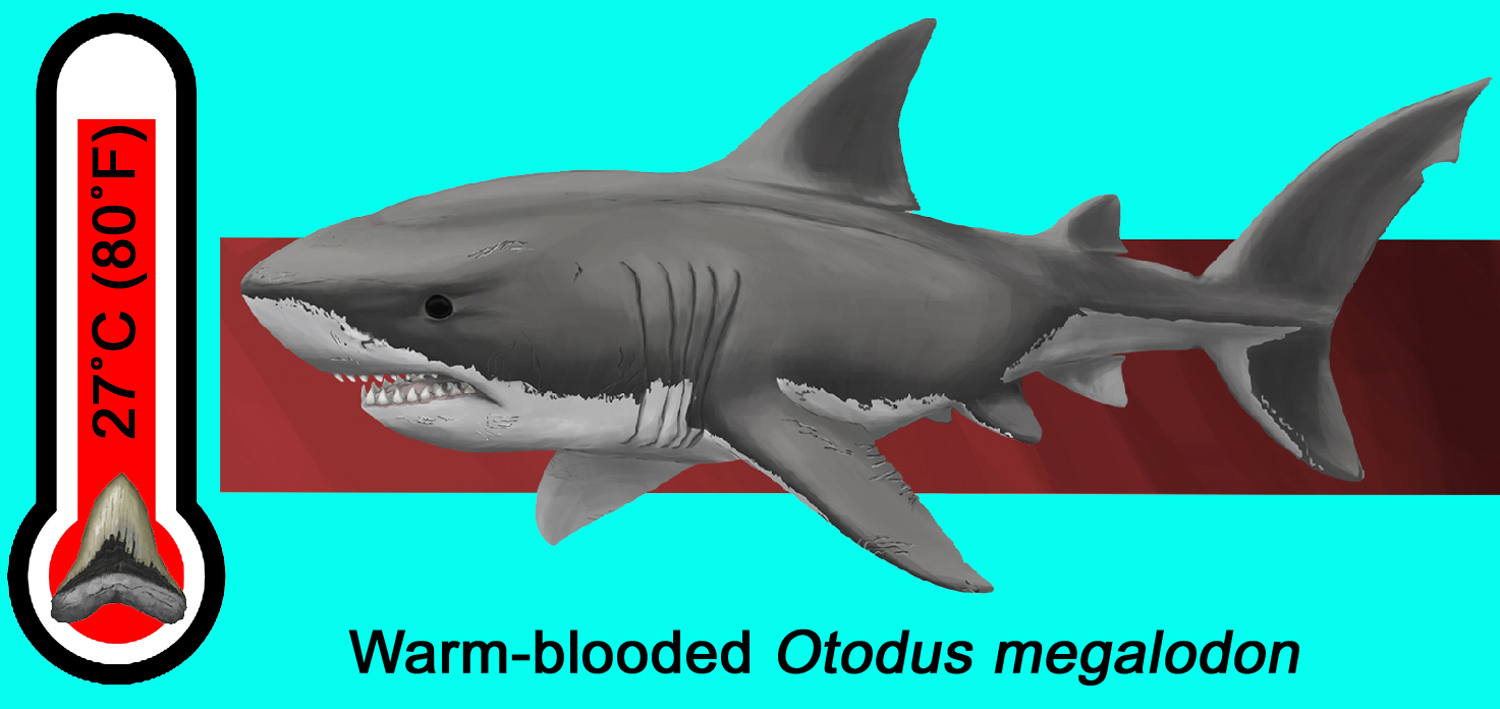 New research from Kenshu Shimada provides evidence Otodus megalodon was warm-blooded. (Illustration by Alex Boersma/PNAS)
New research from Kenshu Shimada provides evidence Otodus megalodon was warm-blooded. (Illustration by Alex Boersma/PNAS)
CHICAGO — A new study finds that the gigantic Megalodon or megatooth shark, which lived nearly worldwide roughly 15-3.6 million years ago and reached at least 50 feet (15 meters) in length, was warm-blooded. This latest research from DePaul University paleobiologist Kenshu Shimada sheds light on the physiology of Megalodon, formally called Otodus megalodon. This discovery also reveals new clues about how climate change may have led to the shark’s demise.
“The new study provides the first empirical evidence of warm-bloodedness in the extinct shark based on geochemical analyses applied to fossilized teeth,” said Shimada, a professor in DePaul’s College of Science and Health. Previous studies have suggested that Otodus megalodon was likely warm-blooded or regionally endothermic like some modern-day sharks, such as makos and great white sharks. “However, the assertion was based on pure inference, and now we have evidence.”
The study, published in the peer-reviewed journal, Proceedings of the National Academy of Sciences, was conceived by co-principal investigators Shimada, Michael Griffiths and Martin Becker at William Paterson University in New Jersey, Robert Eagle at the University of California at Los Angeles, and Sora Kim at the University of California at Merced. Other coauthors of the paper include researchers from Florida Gulf Coast University in Florida, Princeton University in New Jersey, and Goethe University Frankfurt in Germany.
 Kenshu Shimada, professor of paleobiology at DePaul University. (DePaul University/Randall Spriggs)Using geothermal techniques to reveal fossil clues
Kenshu Shimada, professor of paleobiology at DePaul University. (DePaul University/Randall Spriggs)Using geothermal techniques to reveal fossil clues The research team tested the Megalodon endothermy hypothesis using a novel geochemical technique involving ‘clumped isotope thermometry’ and ‘phosphate oxygen isotope thermometry.’ Clumped isotope thermometry is based on the thermodynamic preference of two or more ‘heavy’ isotopes of a particular element to form bonds in a mineral lattice based on the mineralization temperatures. The degree to which these isotopes bond or ‘clump’ together can then reveal the temperature at which the mineral formed. Phosphate oxygen isotope thermometry is based on the principle that the ratio of the stable oxygen isotopes in phosphate minerals depends on the temperature of the water from which they formed.
“Studies using these methods have shown them to be particularly useful in inferring the thermophysiologies of fossil vertebrates of 'unknown' metabolic origins by comparing their body temperature with that of co-occurring fossils of 'known' metabolisms,” explained Griffiths, the lead author of the study.
Researchers found Otodus megalodon had body temperatures significantly higher than sharks considered cold-blooded or ectothermic, consistent with the fossil shark having a degree of internal heat production that modern warm-blooded animals do. Among the modern-day sharks with regional endothermy is a group that includes mako and great white sharks with the previously reported average body temperature ranging from 22 to 26.6 degrees Celsius (C), which may be 10 to 21 C higher than ambient ocean temperature. The new study suggests Otodus megalodon had an overall average body temperature of about 27 C, or roughly 80.6 degrees Fahrenheit.
Otodus megalodon has a rich fossil record abundant with teeth. However, like most other extinct sharks, its biology remains poorly understood because no complete skeleton of the cartilaginous fish is known. “Otodus megalodon was one of the largest carnivores that ever existed, and deciphering the biology of the prehistoric shark offers crucial clues about the ecological and evolutionary roles large carnivores have played in marine ecosystems through geologic time,” said Shimada.
 Researchers found Otodus megalodon had body temperatures significantly higher than sharks considered cold-blooded or ectothermic. (Image courtesy of Kenshu Shimada)Climate change disrupted sharks’ precarious energy balance
Researchers found Otodus megalodon had body temperatures significantly higher than sharks considered cold-blooded or ectothermic. (Image courtesy of Kenshu Shimada)Climate change disrupted sharks’ precarious energy balance The ability of Otodus megalodon to regulate body temperature is evolutionarily profound because the evolution of warm-bloodedness is thought to have also acted as a key evolutionary driver for its gigantism. Previously, regional endothermy was used as a justification to consider Otodus megalodon to resemble the modern great white shark, shape-wise. Although such body form reconstructions remain speculative, this study suggests that Otodus megalodon indeed had a high level of metabolism relative to ectothermic sharks.
High metabolic costs associated with maintaining warm-bloodedness may have contributed, at least in part, to the vulnerability of this species to extinction compared to other shark species that have persisted today. Other recent geochemical investigations have suggested Otodus megalodon was a significant apex predator, residing at the very top of the marine food chain. The species likely incurred high metabolic costs and had high bioenergetic demands.
At the time the megalodon went extinct, there was climate cooling that may have shifted the coastal shelf habitats of its prey. “The implication is that even though Otodus megalodon possessed traits like warm-bloodedness that allowed it to be adaptable to changing ocean temperature, it was not immune to the effects of climate change, highlighting the importance of conservation efforts to protect present-day sharks,” Shimada said.
The study, “Endothermic physiology of extinct megatooth sharks,” will appear in the forthcoming issue of
Proceedings of the National Academy of Sciences. This collaborative work was made possible through financial support from the National Science Foundation Sedimentary Geology and Paleobiology Award to Griffiths and Becker (Award #1830581), Eagle (Award #1830638), Kim (Award #1830480), and Shimada (Award #1830858), and an American Chemical Society Award, Petroleum Research Fund Undergraduate New Investigator Grant (PRF #54852-UNI2) to Griffiths.
###
Source:
Kenshu Shimada
kshimada@depaul.edu
Media contact:
Kristin Mathews
312-362-7735
kristin.mathews@depaul.edu